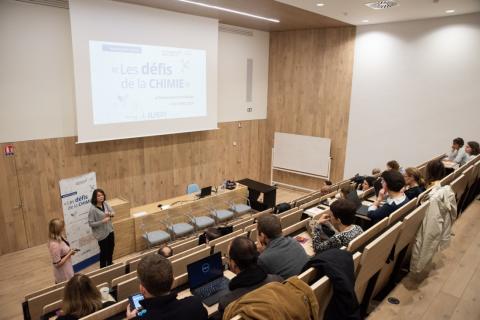
When chemists at Université Paris-Saclay reveal their research to science journalists
The press workshop "The Challenges of Chemistry" that took place on Wednesday, October 9 on the Orsay campus and the Saclay plateau was dedicated to the discovery by science journalists of some examples of the chemistry research being carried out in the laboratories of the university. In addition to the ten or so presentations given by researchers, the public also enjoyed a visit of light lines of the SOLEIL synchrotron.
All chemistry tastes were catered for this Wednesday, October 9, during the press workshop "The Challenges of Chemistry" at Université Paris-Saclay, organized by university's Department of Chemistry, in partnership with the French Association of Science Journalists (AJSPI).
The participants discovered some of the chemistry research themes developed in the laboratories of the university, which boasts 275 labs in all. During the morning session, which took place at the Orsay Institute of Molecular Sciences (ISMO), about ten researchers were on hand to present their recent results, related to health, environment and energy, to an enquiring and interested public. These short presentations, each lasting about fifteen minutes, were based on a single slide and an emblematic object, and provided an excellent opportunity for interaction.
Sandrine Lacombe, from the Orsay Institute of Molecular Sciences (ISMO - Université Paris-Saclay, Université Paris-Sud, CNRS) started the discussion with her presentation on nanoparticles specific for cancer treatment and their contribution to improving radiation treatments. Elias Fattal, from the Galien Institute Paris-Sud (Université Paris-Saclay, Université Paris-Sud, CNRS), followed by detailing the mode of action of nanodrugs. Erwan POUPON, from the Biomolecules: Design, Isolation and Synthesis Laboratory (BIOCIS - Université Paris-Saclay, Université Paris-Sud, CNRS), detailed the development of decisive therapeutic molecules, such as vancomycin, based on Nature's fascinating molecular architectures. Alexandre Maciuk, from the same laboratory, discussed the therapeutic potential of cannabis. His colleague Pierre Champy spoke about herbal health products and traditional medicine, their analytical and health challenges in a context of globalisation and biodiversity erosion. The bee’s protection through the use of molybdenum complexes was at the heart of the presentation given by Sébastien Floquet, from the Lavoisier Institute of Versailles (ILV - Université Paris-Saclay, UVSQ, CNRS). Lithium-ion batteries, all-solid microbatteries, sodium-ion batteries and all-solid sodium batteries were the main focus of the speech of Sylvain Franger, from the Orsay Institute of Molecular Chemistry and Materials (ICMMO - Université Paris-Saclay, Université Paris-Sud, CNRS). Martine Mayne-Lhermitte, from the Nanometric Buildings Laboratory (LEDNA/NIMBE - Université Paris-Saclay, CNRS, CEA), raised the interest of using vertically aligned carbon nanotubes for energy storage by supercapacitors. Ally Aukauloo, from the Orsay Institute of Molecular Chemistry and Materials (ICMMO - Université Paris-Saclay, Université Paris-Sud, CNRS), shared Nature's lessons for the transformation of CO2 through eco-compatible chemistry. Finally Thibault Cantat, from the Molecular Chemistry and Energy Catalysis Laboratory (LCMCE/NIMBE - Université Paris-Saclay, CNRS, CEA), concluded with the valorisation of lignin from biomass waste for CO2 recycling using green catalytic methods.
Raphaël Haumont, from the French Centre for Culinary Innovation in Orsay, also captivated the audience with his presentation of chemistry and molecular cooking during the breakfast break.
The day ended with a visit of three lines of light at the SOLEIL synchrotron in Gif-sur-Yvette: DISCO, PLÉIADES and SAMBA did not fail to illustrate the importance of synchrotron light (hard X-rays and UV in particular) in studies related to chemistry, medicine or environment.
And if you missed this press workshop on chemistry, don't worry, you will have another opportunity to come to Paris-Saclay to discover physics, biology, mathematics, sports science, medicine..., all the richness and dynamism of the research carried out in the university's laboratories. You are welcome, the researchers are waiting for you.
